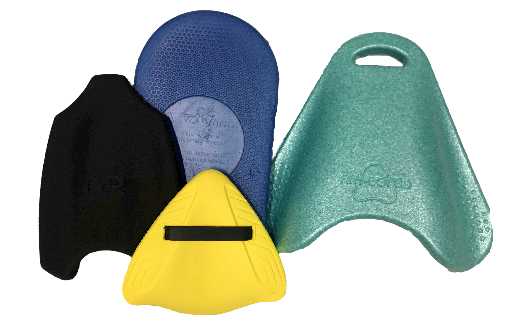Best Large Kickboard for Swimming – 2025
Not All Kickboards are Equal
Swim kickboards come in different shapes and sizes and serve various purposes in swim training. If you’re unfamiliar with the many types of kickboards, check out this review. Many swimmers prefer a large kickboard, one that is thick, buoyant, and positions the body high in the water. In this article, we’ll discuss reasons to use a large kickboard, why a therapeutic kickboard might be the right choice, and which thick kickboards are best for your needs.
Why Choose a Thick or Big Kickboard?
When asked what type of kickboard they prefer, many swimmers say, “I like a thick kickboard” or “I only swim with a large kickboard.” What they mean is that they want a kickboard with plenty of buoyancy—one that keeps their body supported, their head comfortably above water, and their arms relaxed. With less buoyant or thin kickboards, you may find yourself holding the board farther from your body to stay afloat. However, extending your arms straight out for lap after lap is tiring and often leads to shoulder discomfort.
For swimmers using a therapeutic kickboard, the additional buoyancy of a large kickboard can be even more essential. Swim therapy often requires focusing on specific muscle groups or rehabilitation exercises. A big kickboard helps swimmers maintain balance and conserve energy, enabling longer and more effective rehabilitation sessions. This can lead to faster recovery and better results overall.
The Importance of Buoyancy in Kickboards
The buoyancy of a kickboard largely depends on its size. Most quality kickboards are made from foam materials with similar density, typically around 4 pounds per cubic foot. However, the large kickboard or thick kickboard stands out by displacing more water due to its increased width, length, and thickness. This displacement creates more “float” and positions your body higher in the water, making it easier to focus on your kick.
Here’s a comparison of popular kickboards based on their size and buoyancy:
- Finis Alignment Kickboard: 75 cubic inches. A small, minimalist design focused on improving streamline position, not to keep you afloat during normal kicking drills. This is one of the smallest kickboards available.
- TYR Hydrofoil Kickboard: 160 cubic inches. Compact and functional but less buoyant, requiring extended arm positioning. This minimalist board is about half the size of standard kickboards. Its shape offers multiple hand positions, but to stay high in the water you need to swim with your arms fully extended and kick hard. No relaxed, comfortable kicking with this kickboard.
- Standard Blue Kickboard: 220 cubic inches. A classic choice but often lacks the float many swimmers desire. These kickboards can be found at almost any pool. They are all about the same size and shape, and many swimmers find them do be less buoyant than they would like.
- Thick or Large Kickboards (e.g., Kemp): 260 cubic inches. These offer better floatation and comfort for casual swimmers. They allow you to flow higher in the water, but they suffer from the same limitations of all flat kickboards.
- Ray-Board: 375 cubic inches. As the largest and most buoyant option, the Ray-Board outshines standard designs, providing unmatched support and comfort. Ray-Board is more than 50% larger than standard kickboards. It’s unique shape also provides benefits over flat kickboard designs, so you don’t feel like you’re pushing a barge down the swim lane. We’ll tell you more about Ray-Board in a moment.

TYR Hydrofoil Kickboard, Standard Blue Kickboard, Finis Alignment Kickboard, Ray-Board
Why are Some Kickboards Thin?
You may wonder, “Why aren’t all kickboards large or thick?” The answer lies in manufacturing costs and shipping logistics. Smaller kickboards require less material and are cheaper to produce. Additionally, thin kickboards are easier to ship, allowing manufacturers to pack more units per box. While these cost-saving measures make sense for companies, they often compromise the swimmer’s experience.
The Role of Kickboards in Building Endurance
A large kickboard is not just about comfort and buoyancy—it’s a valuable tool for building endurance and improving technique. By isolating your lower body during swim practice, a big kickboard allows you to focus on developing a powerful kick, which is essential for maintaining speed and stability in the water. For beginners, a thick kickboard offers the confidence to practice kicking drills without worrying about sinking or losing balance. Meanwhile, competitive swimmers use therapeutic kickboards to fine-tune their form, build leg strength, and increase stamina. Whether you’re training for a race or simply aiming to become a stronger swimmer, the right kickboard can make a noticeable difference in your performance over time.
Benefits of Ray-Board as a Large Kickboard
For swimmers seeking a large kickboard, the Ray-Board offers a game-changing solution. With 50% more volume than standard kickboards, its buoyancy is unparalleled. The ergonomic design of this big kickboard also makes it stand out. It positions your elbows in a wide, bent posture, allowing your shoulders to relax. The low-in-water design minimizes neck and back strain, making it ideal for recreational swimmers, competitive athletes, and those in swim therapy.
The Ray-Board’s unique combination of superior buoyancy and comfort makes it the best therapeutic kickboard on the market. Whether you’re recovering from an injury or simply looking to enhance your swim training, this thick kickboard ensures you stay afloat with minimal effort.

Ray-Board is sized to provide comfort and keep you buoyant
Choosing the Best Kickboard for You
When selecting a kickboard, consider your swimming goals and comfort preferences. If you prioritize buoyancy, relaxation, and efficient training, opt for a thick kickboard like the Ray-Board. It’s especially helpful for swimmers recovering from injuries or those who spend extended periods practicing their kicks.
Ultimately, the right large kickboard can make a significant difference in your swim experience. Whether you’re training for speed, recovering from therapy, or simply enjoying time in the pool, a big kickboard can support your journey to becoming a stronger swimmer.



